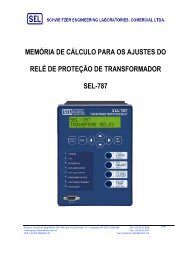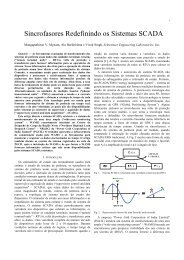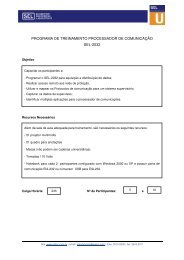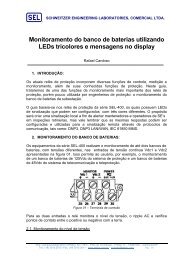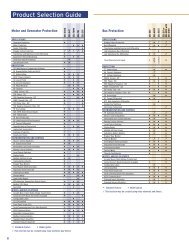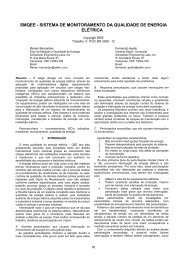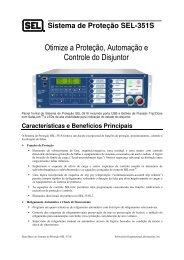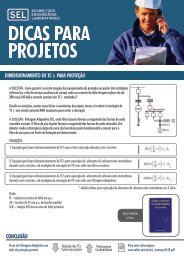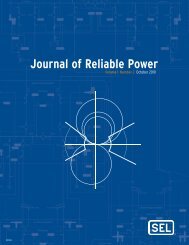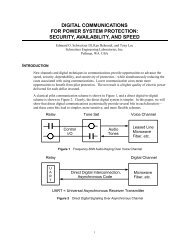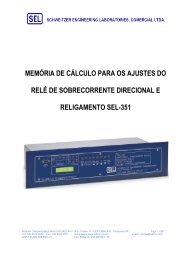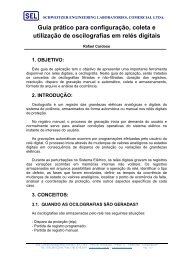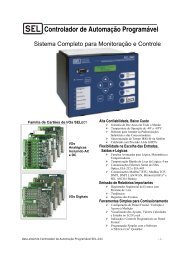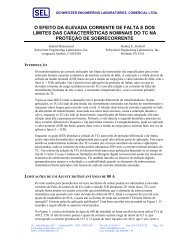Journal of Reliable Power - SEL
Journal of Reliable Power - SEL
Journal of Reliable Power - SEL
You also want an ePaper? Increase the reach of your titles
YUMPU automatically turns print PDFs into web optimized ePapers that Google loves.
3<br />
reasserts, the relay advances to lockout (79LO). The root<br />
cause can be found in the relay operation and user settings [1].<br />
A programmable logic equation (79RI) defines the<br />
conditions that initiate reclose. 79RI is set equal to the rising<br />
edge <strong>of</strong> 67G1 plus a number <strong>of</strong> other conditions logically<br />
ORed together. Once 79RI asserts, the relay enters its cycle<br />
state (79CY) and begins to time to reclose. However, the<br />
reclose timer is interrupted when 79RI reasserts. The relay<br />
immediately assumes something has gone awry, such as a<br />
flashover during a breaker opening, and the relay immediately<br />
goes to lockout (79LO) to prevent further trouble.<br />
just after the fault transitioned from AG to BG; therefore, we<br />
are suspicious that the relay used corrupt data for its fault<br />
location estimate.<br />
A fault location algorithm MathCad simulation is shown in<br />
Fig. 7. We can see the fault location error during the fault type<br />
change, but before and after that transition the location estimate<br />
is consistent.<br />
m<br />
12<br />
9<br />
6<br />
Single-Line-to-Ground Faults (BG)<br />
IA IB IC<br />
2500<br />
0<br />
-2500<br />
IA IB IC IGMag VA(kV) VB(kV) VC(kV)<br />
5.25 cycles<br />
3<br />
0<br />
7 7.5 8 8.5 9 9.5 10 10.5 11 11.5 12 12.5 13<br />
Cycles<br />
IGMag<br />
VA(kV) VB(kV) VC(kV)<br />
Digitals<br />
2000<br />
1000<br />
0<br />
25<br />
0<br />
-25<br />
FSB<br />
FSA<br />
52A<br />
79LO<br />
79CY<br />
79RS<br />
67G1T<br />
51G<br />
TRIP<br />
5.0 7.5 10.0 12.5 15.0 17.5<br />
Cycles<br />
Fig. 6. Reclosing Interrupted by Evolving Fault<br />
To prevent this from happening in the future, reclosing<br />
must not be reinitiated before reclose open-interval timing is<br />
complete and the breaker has been reclosed. Use the trip<br />
element to initiate reclose. Relays have a minimum trip<br />
duration time, so trip outputs remain asserted throughout<br />
evolving faults.<br />
It is also common to stall open-interval timing while the<br />
trip condition is still present. Additionally, there are likely<br />
conditions included in the trip logic for which we do not want<br />
to reclose. These conditions can be specified in a programmable<br />
drive-to-lockout equation (79DTL). Such conditions may<br />
include remote or manual OPEN commands, relay trips for<br />
three-phase faults, or time-delayed trips.<br />
An interesting breaker problem is also evident by the data<br />
in Fig. 6. Notice that the breaker status contact (52A) changes<br />
state shortly after the main breaker interrupts current. This is<br />
consistent with breaker operations in the previous two<br />
examples. However, we see that while the main breaker<br />
contacts remain open, the breaker auxiliary status contact<br />
bounces closed after 0.75 cycles and remains closed for 3.5<br />
cycles before opening again. Bouncy auxiliary contacts can<br />
cause reclosing failures. If 52A asserts before the relay calls<br />
for a close, relay logic assumes a manual or remote CLOSE<br />
command asserted. The auxiliary contacts <strong>of</strong> this breaker need<br />
maintenance to prevent future problems.<br />
The relay reported a fault location <strong>of</strong> 3.22 miles and a BG<br />
fault type. The contiguous fault data are roughly from Cycle 8<br />
to 13, which was the window <strong>of</strong> time the triggering element<br />
51G was asserted. The midpoint <strong>of</strong> that data corresponds to<br />
Fig. 7. MathCad Fault Location Estimates for AG and BG Fault Types<br />
The relay fault location algorithm selected data just prior to<br />
Cycle 10.5, where the B-phase current is still increasing to its<br />
maximum value. Therefore, its estimate is slightly further<br />
away from the local terminal because <strong>of</strong> the lower current<br />
magnitude used. The actual fault location is closer to 3.0<br />
miles.<br />
IV. COMMUNICATIONS PROBLEM<br />
In June 2007, a fault occurred beyond the remote terminal<br />
<strong>of</strong> a 115 kV line protected by a DCB scheme. DCB schemes<br />
use a high-speed on/<strong>of</strong>f carrier signal to block high-speed<br />
tripping at the remote terminal for out-<strong>of</strong>-section faults.<br />
Therefore, we expected the remote terminal to send a blocking<br />
signal to the local relay to prevent it from tripping at a high<br />
speed.<br />
The event data recorded from the local relay are shown in<br />
Fig. 8. The received blocking signal was wired to a programmable<br />
input on the relay (IN5) and appears to have been<br />
asserted at the time <strong>of</strong> the trip.<br />
IA IB IC<br />
IRMag<br />
VA VB VC<br />
Digitals<br />
100<br />
0<br />
-100<br />
75<br />
50<br />
25<br />
0<br />
50<br />
0<br />
-50<br />
Fig. 8.<br />
IA IB IC IRMag VA VB VC<br />
OUT 1&2<br />
B<br />
IN 5&6 5 5<br />
67N 2<br />
-1 0 1 2 3 4 5 6 7 8 9 10 11<br />
Cycles<br />
Four Samples-per-Cycle Data From a DCB Scheme Trip<br />
The relay is set so that overreaching phase and ground<br />
elements are allowed to trip after a one-cycle carrier<br />
coordination delay if no block is received. However, the relay<br />
tripped by overreaching ground directional overcurrent ele-<br />
54 | <strong>Journal</strong> <strong>of</strong> <strong>Reliable</strong> <strong>Power</strong>



